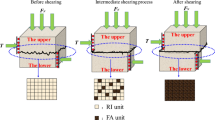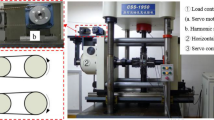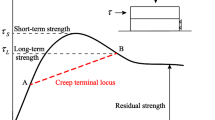Abstract
As a common geological structure, rock joints have a great influence on the mechanical properties and stability of rock mass engineering. The shear constitutive model of the rock joint and its calculation methods have played an important role in theoretical and experimental research. Most of the existing elastic–plastic shear constitutive models of the rock joint are simplified to linear form or only considering hardening behavior, while the shear test results show that the post-peak nonlinear softening curve is the most common form for shear curves. Therefore, based on Barton shear strength criterion, the shear stress softening is characterized by the change of the post-peak joint roughness coefficient (JRC), and an increment elastic–plastic constitutive model reflecting the shear stress softening is established. According to the constraint condition of constant normal stress, the increment model of the normal deformation with shear deformation is obtained. Based on principle of the implicit return mapping algorithm, an algorithm for the shear softening elastic–plastic constitutive model in the stress space is established. The applicability and rationality of the model and algorithm are verified by a large number of the joint shear experiment results under different conditions. The established elastic–plastic constitutive model provides an effective reference for correctly evaluating the shear deformation characteristics of the joint.









Similar content being viewed by others
References
Do, T.N.; Wu, J.H.: Simulation of the inclined jointed rock mass behaviors in a mountain tunnel excavation using DDA. Comput. Geotech. 117, 103249 (2020)
Xing, Y.; Kulatilake, P.H.S.; Sandbak, L.A.: Effect of rock mass and discontinuity mechanical properties and delayed rock supporting on tunnel stability in an underground mine. Eng. Geol. 238(2), 62–75 (2018)
Yang, T.; Liu, H.Y.; Tang, C.A.: Scale effect in macroscopic permeability of jointed rock mass using a coupled stress–damage–flow method. Eng. Geol. 228(13), 121–136 (2017)
Barton, N.: A review of mechanical over-closure and thermal over-closure of rock joints: Potential consequences for coupled modelling of nuclear waste disposal and geothermal energy development. Tunnel. Underground Space Technol. 99, 103379 (2020)
Ghazvinian, A.; Hadei, M.R.: Effect of discontinuity orientation and confinement on the strength of jointed anisotropic rocks. Int. J. Rock Mech. Min. Sci. 55, 117–124 (2012)
Satici, O.; Unver, B.: Assessment of tunnel portal stability at jointed rock mass: a comparative case study. Comput. Geotech. 64, 72–82 (2015)
Farahmand, K.; Vazaios, I.; Diederichs, M.S.; Vlachopoulos, N.: Investigating the scale-dependency of the geometrical and mechanical properties of a moderately jointed rock using a synthetic rock mass (SRM) approach. Comput. Geotech. 95, 162–179 (2018)
Wang, P.T.; Ren, F.H.; Miao, S.J.; Cai, M.F.; Yang, T.H.: Evaluation of the anisotropy and directionality of a jointed rock mass under numerical direct shear tests. Eng. Geol. 225(20), 29–41 (2017)
Abolfazli, M.; Fahimifar, A.: An investigation on the correlation between the joint roughness coefficient (JRC) and joint roughness parameters. Const. Build. Mater. 259, 12045 (2020)
Bost, M.; Mouzannar, H.; Rojat, F.; Coubard, G.; Rajot, J.P.: Metric scale study of the bonded concrete-rock interface shear behaviour. KSCE J. Civil Eng. 24(2), 390–403 (2019)
Tiwari, G.; Latha, G.M.: Shear velocity-based uncertainty quantification for rock joint shear strength. Bull. Eng. Geol. Environ. 78, 5937–5949 (2019)
Dewers, T.A.; Issen, K.A.; Holcomb, D.J.; Olsson, W.A.; Ingraham, M.D.: Strain localization and elastic-plastic coupling during deformation of porous sandstone. Int. J. Rock Mech. Min. Sci. 98, 167–180 (2017)
Li, H.Z.; Xiong, G.D.; Zhao, G.P.: An elasto-plastic constitutive model for soft rock considering mobilization of strength. Trans. Nonferrous Metals Soc. China 26, 822–834 (2016)
Plesha, M.E.: Constitutive models for rock discontinuities with dilatancy and surface degradation. Int. J. Numer. Anal. Methods Geomech. 11, 345–362 (1987)
Plesha, M.E.: Rock joints: theory, constitutive equations. Stud. Appl. Mech. 42, 375–393 (1995)
Jing, L.; Nordlund, E.; Stephansson, O.: A 3-D constitutive model for rock joints with anisotropic friction and stress dependency in shear stiffness. Int. J. Rock Mech. Min. Sci. Geomech. Abst. 31(2), 173–178 (1994)
Desai, C.S.; Fishman, K.L.: Plasticity-based constitutive model with associated testing for joints. Int. J. Rock Mech. Min. Sci. Geomech. Abst. 28(1), 15–26 (1991)
Wang, J.G.; Ichikawa, Y.; Leung, C.F.: A constitutive model for rock interfaces and joints. Int. J. Rock Mech. Min. Sci. 40, 41–53 (2003)
Haberfield, C.M.; Szymakowski, J.: Applications of large scale direct shear testing. Aust. Geomech. J. 38(1), 29–39 (2003)
Wu, K.; Shao, Z.; Qin, S.; Wei, W.; Chu, Z.: A critical review on the performance of yielding supports in squeezing tunnels. Tunnel. Underground Space Technol. 115, 103815 (2021)
Dang, W.G.; Konietzky, H.; Fruhwirt, T.: Rotation and stress changes on a plane joint during direct shear tests. Int. J. Rock Mech. Min. Sci. 89, 129–135 (2016)
Wang, G.H.; Wang, Y.X.; Lu, W.B.; Yan, P.; Zhou, W.; Chen, M.: A general definition of integrated strong motion duration and its effect on seismic demands of concrete gravity dams. Eng. Struct. 125, 481–493 (2016)
Barton, N.: Review of a new shear strength criterion for rock joints. Eng. Geol. 7, 287–332 (1973)
Barton, N.R.: Non-linear shear strength descriptions are still needed in petroleum geomechanics, despite 50 years of linearity. ARMA 16–252 (2016)
Asadollahi, P.; Tonon, F.: Constitutive model for rock fractures: revisiting Barton’s empirical model. Eng. Geol. 113, 11–32 (2010)
Plesha, M.E.; Ballarini, R.: Constitutive model and finite element procedure for dilatant contact problems. J. Eng. Mech. 115, 2649–2667 (1989)
Serrano, A.; Olalla, C.; Reig, I.: Convergence of circular tunnels in elastoplastic rock masses with non-linear failure criteria and non-associated flow laws. Int. J. Rock Mech. Min. Sci. 48, 878–887 (2011)
Yang, C.X.; Wu, Y.H.; Hon, T.: A no-tension elastic–plastic model and optimized back-analysis technique for modeling nonlinear mechanical behavior of rock mass in tunneling. Tunnel. Underground Space Technol. 25, 279–289 (2010)
Olsson, R.; Barton, N.: An improved model for hydromechanical coupling during shearing of rock joints. Int. J. Rock Mech. Min. Sci. 38, 317–329 (2001)
Barton, N.: A model study of rock joint deformation. Int. J. Rock Mech. Min. Sci. 9, 570–602 (1972)
Barton, N.; Choubey, V.: The shear strength of rock joints in theory and practice. Rock Mech. 10, 1–54 (1977)
Son, B.K.; Lee, Y.K.; Lee, C.I.: Elasto-plastic simulation of a direct shear test on rough rock joints. Int. J. Rock Mech. Min. Sci. 41, 1–6 (2004)
Li, K.; Huang, L.H.; Huang, X.C.: Propagation simulation and dilatancy analysis of rock joint using displacement discontinuity method. J. Central South Univ. 21, 1184–1189 (2014)
Yang, Z.Y.; Chiang, D.Y.: An experimental study on the progressive shear behavior of rock joints with tooth-shaped asperities. Int. J. Rock Mech. Min. Sci. 37(8), 1247–1259 (2000)
Bandis, S.C.; Lumsden, A.C.; Barton, N.R.: Fundamentals of rock joint deformation. Int. J. Rock Mech. Min. Sci. Geomech. Abst. 20(6), 249–268 (1983)
Prassetyo, S.H.; Gutierrez, M.; Barton, N.: Nonlinear shear behavior of rock joints using a linearized implementation of the Barton-Bandis model. J. Rock Mech. Geotech. Eng. 9, 671–682 (2017)
Bandis, S.C.; Lumsden, A.C.; Barton, N.: Experimental studies of scale effects on the shear behaviour of rock joints. Int. J. Rock Mech. Min. Sci. Geomech. Abst. 18, 1–21 (1981)
Lee, H.S.; Park, Y.J.; Cho, T.F.; You, K.H.: Influence of asperity degradation on the mechanical behavior of rough rock joints under cyclic shear loading. Int. J. Rock Mech. Min. Sci. 38, 967–980 (2001)
Hou, D.; Rong, G.; Yang, J.; Zhou, C.B.; Peng, J.; Wang, X.J.: A new shear strength criterion of rock joints based on cyclic shear experiment. Eur. J. Environ. Civil Eng. 20(2), 180–198 (2016)
Zhang, X.B.; Jiang, Q.H.; Chen, N.; Wei, W.; Feng, X.X.: Laboratory investigation on shear behavior of rock joints and a new peak shear strength criterion. Rock Mech. Rock Eng. 49, 3495–3512 (2016)
Jiang, Q.; Yang, B.; Yan, F.; Liu, C.; Shi, Y.G.; Li, L.F.: New method for characterizing the shear damage of natural rock joint based on 3D engraving and 3D scanning. Int. J. Geomech. 20(2), 06019022 (2020)
Liu, H.; Zhao, Z.M.; Chen, J.Y.; Liu, D.Y.: Empirical shear strength criterion for rock joints based on joint surface degradation characteristics during shearing. Rock Mech. Rock Eng. 53, 3609–3624 (2020)
Mahmound, B.; Nateghpour, B.; Tavakoil, J.; Broujerdi, M.S.: Comparison of experimental and empirical methods for estimating the shear strength of rock joints based on the statistical approach. Environ. Earth Sci. 79, 361 (2020)
Nukala, P.K.V.V.: A return mapping algorithm for cyclic viscoplastic constitutive models. Comput. Methods Appl. Mech. Eng. 195(1/2/3), 148–178 (2006)
Huang, J.S.; Griffiths, D.V.: Return mapping algorithms and stress predictors for failure analysis in geomechanics. J. Eng. Mech. 135(4), 276–284 (2009)
Kornerup, P.; Muller, J.M.: Choosing starting values for certain Newton-Raphson iterations. Theor. Comput. Sci. 351, 101–110 (2006)
Gagunashvili, N.D.; Halldorsson, H.; Neukirchen, H.: CHICOM: code for comparing weighted or unweighted histograms in Fortran-77, C++, R and Python. Comput. Phys. Commun. 245, 106872 (2019)
Fan, Z.L.: A study of variable step-length incremental/iterative methods for nonlinear finite element equations. Comput. Struct. 52, 1269–1275 (1994)
Gharouni, N.M.; Fathali, M.: Investigating the effect of dilation on VNL and CNL types shear strength. Int. J. Civil Eng. 11(1B), 65–70 (2013)
Park, J.W.; Lee, Y.K.; Song, J.J.; Choi, B.H.: A constitutive model for shear behavior of rock joints based on three-dimensional quantification of joint roughness. Rock Mech. Rock Eng. 46, 1513–1537 (2013)
Abolfazli, M.; Fahimifar, A.: The effects of rock joint characteristics and normal stress level on the stiffness of rock joints. Arab. J. Geosci. 13, 984 (2020)
Flamand, R.; Archambault, G.; Gentier, S.; Riss, J.; Rouleau, A.: An experimental study of the shear behavior of irregular joints based on angularities and progressive degradation of the surfaces. In: Proceedings of the 47th Canadian Geotechnical Conference pp 253–263 (1994)
Li, Y.; Oh, J.; Mitra, R.; Hebblewhite, B.: A constitutive model for a laboratory rock joint with multi-scale asperity degradation. Comput. Geotech. 72, 143–151 (2016)
Li, Z.D.; Ke, C.R.; Wang, S.L.; Wen, Q.W.; Liu, Z.J.: Post-peak shear deformation characteristics of jointed specimens. J. Hubei Univ. Technol. 33(5), 88–92 (2018)
Develi, K.: Computation of direction dependent joint surface parameters through the algorithm of triangular prism surface area method: a theoretical and experimental study. Int. J. Solids Struct. 202, 895–911 (2020)
Li, K.H.; Cao, P.; Zhang, K.; Zhong, Y.F.: Macro and meso characteristics evolution on shear behavior of rock joints. J. Central South Univ. 22, 3087–3096 (2015)
Kumar, R.; Verma, A.K.: Anisotropic shear behavior of rock joint replicas. Int. J. Rock Mech. Min. Sci. 90, 62–73 (2016)
Hedayat, A.; Haeri, H.; Hinton, J.; Masoumi, H.; Spagnoli, G.: Geophysical signatures of shear-induced damage and frictional processes on rock joints. J. Geophys. Res. Solid Earth 123, 1143–1160 (2018)
Gui, Y.; Xia, C.C.; Ding, W.Q.; Qian, X.; Du, S.G.: Modelling shear behaviour of joint based on joint surface degradation during shearing. Rock Mech. Rock Eng. 52, 107–131 (2019)
Pirzada, M.A.; Roshan, H.; Sun, H.; Oh, J.; Andersen, M.S.; Hedayat, A.; Bahaaddini, M.: Effect of contact surface area on frictional behaviour of dry and saturated rock joints. J. Struct. Geol. 135, 104044 (2020)
Zhao, Y.L.; Zhang, C.S.; Wang, Y.X.; Lin, H.: Shear-related roughness classification and strength model of natural rock joint based on fuzzy comprehensive evaluation. Int. J. Rock Mech. Min. Sci. 137, 104550 (2021)
Acknowledgements
This work presented in this paper was funded by National Natural Science Foundation of China (No. 51478031, 51278046). Thanks to Beijing Jiaotong University's International Academic Communication Writing Center for the modification of the language of this paper. The authors are grateful to the editor and reviewer for discerning comments on this paper.
Author information
Authors and Affiliations
Corresponding author
Ethics declarations
Conflict of interest
The authors declare that there is no conflict of interest regarding the publication of this article.
Supplementary Information
Below is the link to the electronic supplementary material.
Rights and permissions
About this article
Cite this article
Feng, W., Qiao, C., Feng, MY. et al. Nonlinear Constitutive Model of Rock Joint in Geological Structure and Application of Implicit Return Mapping Algorithm. Arab J Sci Eng 47, 4041–4057 (2022). https://doi.org/10.1007/s13369-021-05851-w
Received:
Accepted:
Published:
Issue Date:
DOI: https://doi.org/10.1007/s13369-021-05851-w




